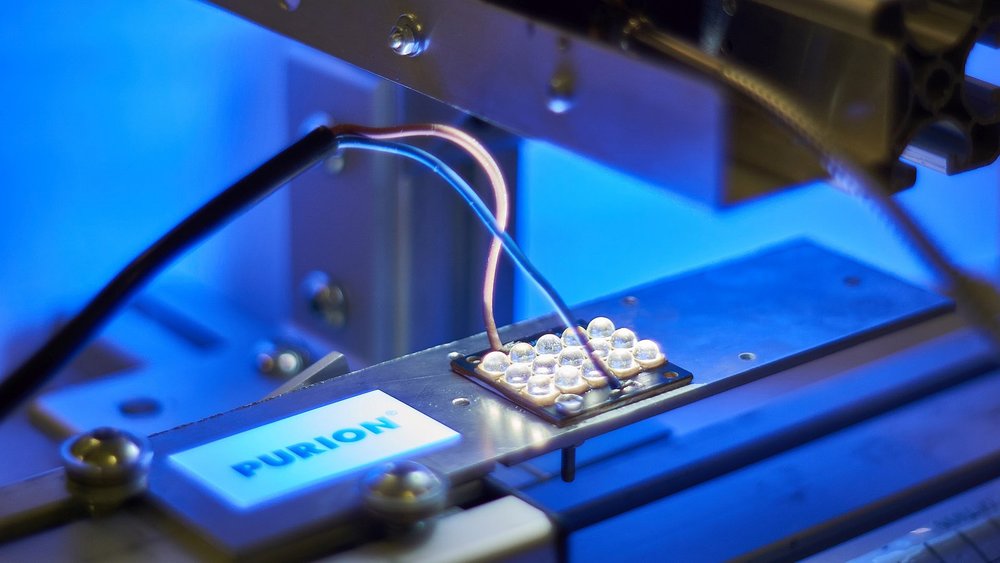www.magazine-industry-usa.com
20
'19
Written on Modified on
Hygienic beer caps thanks to Fraunhofer technology
UV light inactivates germs in drinking water.

The technology is also suitable for disinfecting brewing water and for disinfecting the caps for bottled beer, soft drinks, and mineral water during the filling process.
Summertime is beer garden time. To ensure clean water for high-quality beer, brewing companies often install ultraviolet (UV) systems upstream of their brewing equipment, with the purpose of keeping the drinking water free of germs. UV light is used because it is very effective in killing bacteria, viruses and germs. Their genetic material (DNA) is destroyed by the UV rays.
The brewing water is disinfected by pumping it through stainless steel tubes in which UV lamps have been fitted. UV light with a wavelength of 265 nanometers is especially suitable for this task. Up to now, this UV light has been generated using mercury-vapor lamps, which emit light at 254 nanometers. However, mercury is a heavy metal that damages the environment.
Researchers at the Advanced System Technology (AST) branch of the Fraunhofer Institute for Optronics, System Technologies and Image Exploitation IOSB in Ilmenau, in collaboration with project partner PURION GmbH, want to replace the conventional lamps containing mercury with ultraviolet light-emitting diodes (UV LEDs).
Based in the German town of Zella-Mehlis, the company manufactures UV disinfection systems for purifying water. The technology is used in water coolers, for example, but also to keep drinks containers such as barrels, bottles and cans free of germs.
Cell-damaging UV-C LEDs
“Conventional mercury-vapor lamps emit light at 254 nanometers. As this lies below the optimal wavelength of 265 nanometers, the disinfection performance is not optimal,” says Thomas Westerhoff, scientist at Fraunhofer IOSB-AST. Further disadvantages of these lamps are their long warm-up phases, their short service lives and the fact that they cannot be deployed flexibly due to their bulky design.
“For these reasons, we prefer UV LEDs, which emit at a maximum wavelength of 265 nanometers. Of particular interest are UV-C LEDs, because their radiation destroys the DNA of the pathogens much more effectively. The UV rays generate resonances in the nucleic acids of the DNA and break the bonds of the molecules open. This changes the cell nuclei of the micro-organisms in a way that renders cell division impossible. Consequently, the pathogens can no longer multiply.”
Flexible design of highly stable, mercury-free UV radiation sources
In contrast to the problematic mercury-vapor lamps, UV LEDs do not require any warm-up phase – they reach full power instantly. In addition, they offer high mechanical stability, are not toxic and can be operated at low voltage. Another advantage is that LEDs are spotlights. By virtue of their radiation pattern, they offer a wide range of design possibilities.
Westerhoff and his team at Fraunhofer IOSB-AST are responsible for the design of the LED modules, answering questions such as: “How do the geometries have to be structured?”, “What is the optimum layout of the arrays for a particular use case?”, “How many LEDs are needed?” and “How should point sources with different wavelengths be arranged on the module?”
Following numerous practical tests, the researchers are now able to operate the UV LEDs directly in water without the need for a tube to encase them. Thus they eliminate reflections to further increase the performance yield of the radiation sources.
For the industrial partner PURION GmbH, the experts at Fraunhofer IOSB-AST have developed a special module that can disinfect the insides of beer caps during the production process before the bottles are filled with beer. This ensures that no germs get into the bottles during the production process. “We’re able to irradiate the inner surface of the caps with a UV power of four watts. Doing that with mercury-vapor lamps on such a small surface is almost impossible,” says the engineer.
The new technology is highly versatile, and thanks to their small size and high radiation intensity the UV-C LEDs can also be used in medical devices, in order to sterilize liquids, surfaces and difficult-to-reach areas in a targeted manner.
Endoscopes and ultrasonic probes, for example, can be efficiently disinfected using specially configured LED arrangements despite the complex irradiation geometries. Fraunhofer IOSB-AST also offers its expertise to interested customers in the medical engineering sector in the design of LED-based UV-C radiation sources and the simulation and optimization of the irradiation field.
The technology project was supported by the German Federal Ministry of Education and Research (BMBF) as part of its 2020 Initiative “Advanced UV for Life.”
www.fraunhofer.com

